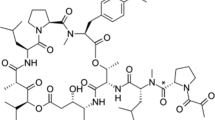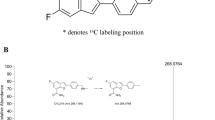Abstract
The benzaldehyde derivative 4,6-benzylidene-d-glucose (BG) induces an inhibition of protein synthesis at otherwise non-toxic doses in cells grown in vitro. To increase the biological effect of BG, the hydrogen in the formyl group was exchanged with deuterium, resulting in 4,6-benzylidene-d 1-d-glucose (P-1013). In this study we compared the bioavailability of BG and P-1013, since both intraperitoneal and, especially, oral administration of the drugs would be a great advantage. We also examined whether or not P-1013 displays dose-dependent pharmacokinctics. Pharmacokinetics were studied by analysing plasma samples using reversed-phase high-performance liquid chromatography (HPLC). P-1013 was given at four different doses i.v. (60, 120, 145 and 230 mg/kg) and p.o. (60, 120, 170 and 230 mg/kg) to female Bom:NMRI-numice. The bioavailability was more than 50% for all doses. The results also indicate that P-1013 shows linear pharmacokinetics, with no change being observed in the half-life (t1/2) with increasing dose and only a slightly more than proportional increase in the area under the concentration-time curve (AUC) occurring with increasing dose. A doubling in dose resulted in a 2.2-fold increase in the AUC. P-1013 and BG were also given i.v., p.o. and i.p. to female nu/nu-BALB/cABom mice and male Wistar rats. A high degree of bioavailability was found in both species, with 55–100% of the deliverered dose being absorbed. Deuteration of BG does not seem to alter its bioavailability, as we found the same bioavailability for P-1013 as for BG. We conclude that the pharmacokinetics of P-1013 does not prevent its use as a cancer treatment drug given orally.
Similar content being viewed by others
References
Børretzen B, et al (1989) Anticancer compounds. United States Patent 4874780. United States Patent Office, Washington, D.C.
Dornish JM, Larsen RO, Schwarze PE, Børretzen B, Pettersen EO (1990) In vivo and in vitro pharmacokinetics of 4,6-benzylidened-glucose (BG) in rats. Invest New Drugs 8: 149–157
Dunsæd CB, Dornish JM, Aastveit TE,Pettersen EO (1993) In vivo pharmacokinetics of the anti-tumour agent 4,6-benzylidene-d-glucose (BG) and a deuterated analog 4,6-benzylidene-d 1-d-glucose (P-1013) in mice, rats and dogs. Int J Oncol 2: 61–66
Hartwell JL (1970) Plants used against cancer. A survey. Lloydia 33: 97–194
Kochi M, Takeuchi S, Mitzutani T, Mochizuki K, Matsumato Y, Saito Y (1980) Antitumour activity of benzaldehyde. Cancer Treat Rep 64: 21–23
Kochi M, Amamiya K, Niwayam M (1982) Antitumor activity of benzaldehyde derivative (abstract). Proceedings, 13th International Cancer Congress, Seattle, Washington, September 8–15, p 200
Kochi M, Isono N, Niwayama M, Shirakabe K (1985) Antitumour activity of a benzaldehyde derivative. Cancer Treat Rep 69: 533–537
Kochi M, Ueda S, Hagiwara T (1988) Antitumour activity of sodium benzylideneascorbate. In: Bresciani F, King RBJ, Lippman ME, Raynard JP (eds) Progress in cancer research and therapy, vol 35. Hormones and cancer 3. Raven, New York, pp 338–343
Kutzman RS, Meyer GJ, Wolf AP (1980) Biodistribution and excretion of [11C]benzaldehyde by the rat after two-minute inhalation exposures. Xenobiotica 10: 281–288
Pettersen EO, Nome O, Rønning ØW, Oftebro R (1983) Effects of benzaldehyde on survival and cell-cycle kinetics of human cells cultivated in vitro. Eur J Cancer Clin Oncol 19: 507–514
Pettersen EO, Rønning ØW, Nome O, Oftebro R (1983) Effects of benzaldehyde on protein metabolism of human cells cultivated in vitro. Eur J Cancer Clin Oncol 19: 935–940
Pettersen EO, Dornish JM, Rønning ØW (1985) 4,6-Benzylidene-d-glucose, a benzaldehyde derivative that inhibits protein synthesis but not mitosis of NHIK 3025 cells. Cancer Res 45: 2085–2091
Pettersen EO, Schwarze PE, Dornish JM, Nesland JM (1986) Antitumour effect of benzylidene-glucose (BG) in rats with chemically induced hepatocellular carcinoma. Anticancer Res 6: 147–152
Pettersen EO, Larsen RO, Børretzen B, Dornish JM, Oftebro R (1991) Increased effect of benzaldehyde by exchanging the hydrogen in the formyl group with deuterium. Anticancer Res 11: 369–374
Pettersen EO, Larsen RO, Børretzen B, Dornish JM, Oftebro R (1991) Effect of protein synthesis and cell survival of the benzaldehyde derivative sodium benzylidene ascorbate and the deuterated compound zilascorb(2H). Anticancer Res 11: 1077–1082
Pettersen EO, Larsen RO, Dornish JM, Børretzen B, Juul MEH, Astveit TE, Nesland JM, Rofstad EK, Oftebro R (1993) Tumour necrotisation in nude mice xenografts by the reversible protein synthesis inhibitor zilascorb(2H). Br J Cancer 67: 650–656
Powis G, Matthew MA, Kovach JS (1981) Dose-dependent pharmacokinetics and cancer chemotherapy. Cancer Chemother Pharmacol 6: 1–9
Rowland M, Tozer TN (1989) Clinical pharmacokinetics, 2nd edn. Lea & Febiger, Philadelphia, p 42
Sakagami H, Asano K, Fukuchi K, Gomi K, Ota H, Kazama K, Tanuma S, Kochi M (1991) Induction of tumor degeneration by sodium benzylideneascorbate. Anticancer Res 11: 1533–1538
Taetle R, Howell SB (1983) Preclinical re-evalution of benzaldehyde as a chemotherapeutic agent. Cancer Treat Rep 67: 561–566
Takeuchi S, Kochi M, Sakaguchi K, Nakagawa K, Mitzutani T (1978) Benzaldehyde as a carcinostatic principle in figs. Agric Biol Chem 42: 1449–1451
Tanum G, Tveit KM, Høst H, Pettersen EO (1990) Benzylideneglucose: no effect after all? Am J Clin Oncol 13: 161–163
Tatsumura T, Nishide R, Koyama S, Ohba Y, Tsujimoto M, Yago O, Tsuda M, Sato H, Man A, Yamamoto K, Komoni Y (1987) Antitumour effect of 4,6-benzylidene-d-glucose in clinical studies. Proc Am Soc Clin Oncol 6: 142
Tatsumura T, Tsusjimoto, Koyama S, Furuno T, Komori Y, Sato H, Yamamoto K, Kitagawa M, Kagamimori S (1990) 4,6-Benzylidene-d-glucopyranose (BG) in the treatment of solid malignant tumours, an extended phase I study. Br J Cancer 62: 436–443
Author information
Authors and Affiliations
Rights and permissions
About this article
Cite this article
Dunsæd, C.B., Dornish, J.M. & Pettersen, E.O. The bioavailability and dose dependency of the deuterated anti-tumour agent 4,6-benzylidene-d 1-d-glucose in mice and rats. Cancer Chemother. Pharmacol. 35, 464–470 (1995). https://doi.org/10.1007/BF00686830
Received:
Accepted:
Issue Date:
DOI: https://doi.org/10.1007/BF00686830




